Abstract
Reversed passive hemagglutination was used to assay enterotoxin in culture filtrates and in food samples. With cells tanned and then sensitized with antitoxin globulin and preserved with either formaldehyde or pyruvic aldehyde, as little as 0.0007 μg of enterotoxin was detectable. The results of hemagglutination tests compared well with those obtained by quantitative precipitin tests or by immunodiffusion, but hemagglutination was 50 to 100 times more sensitive than the immunodiffusion technique. In addition, results of the hemagglutination test were available within a few hours, and neither elimination of interfering proteins from food extracts nor concentration of the sample, both of which are necessary for immunodiffusion, was required for this procedure.
Full text
PDF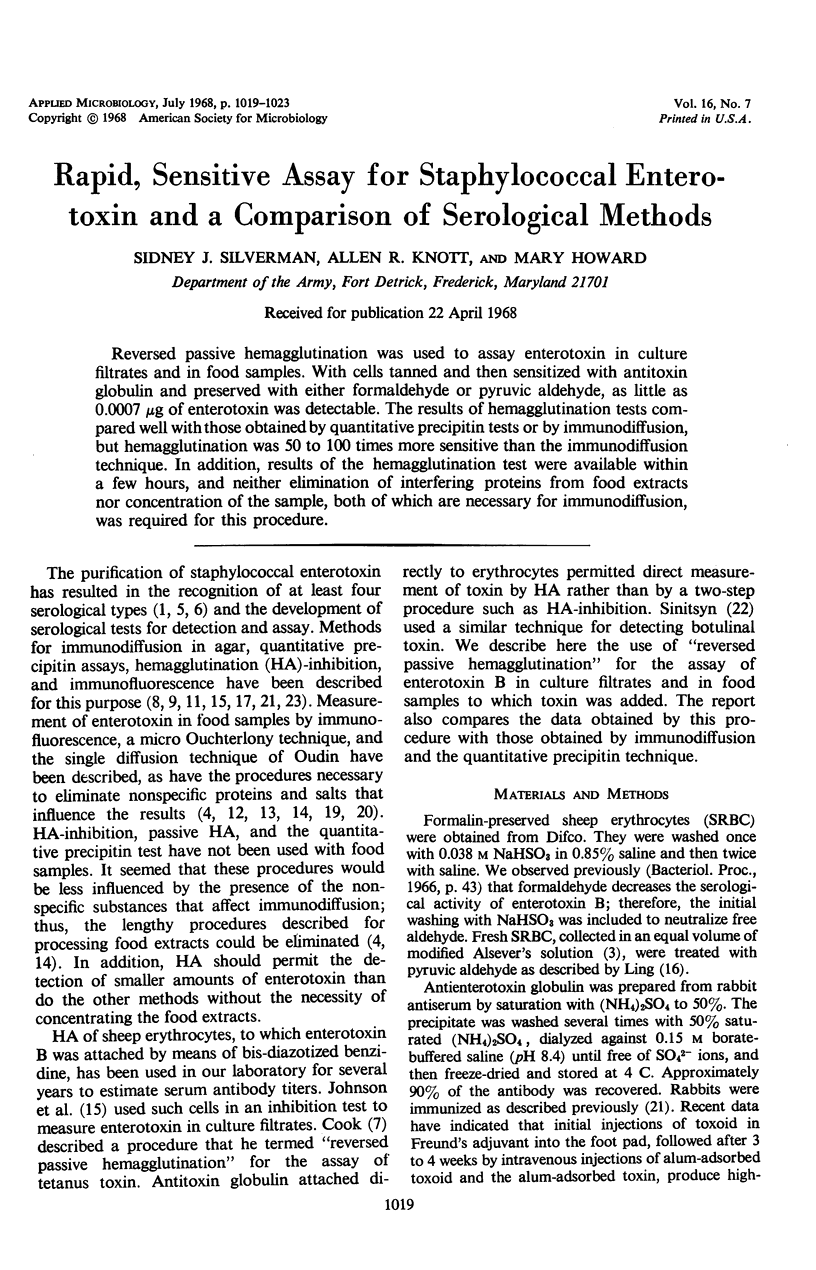
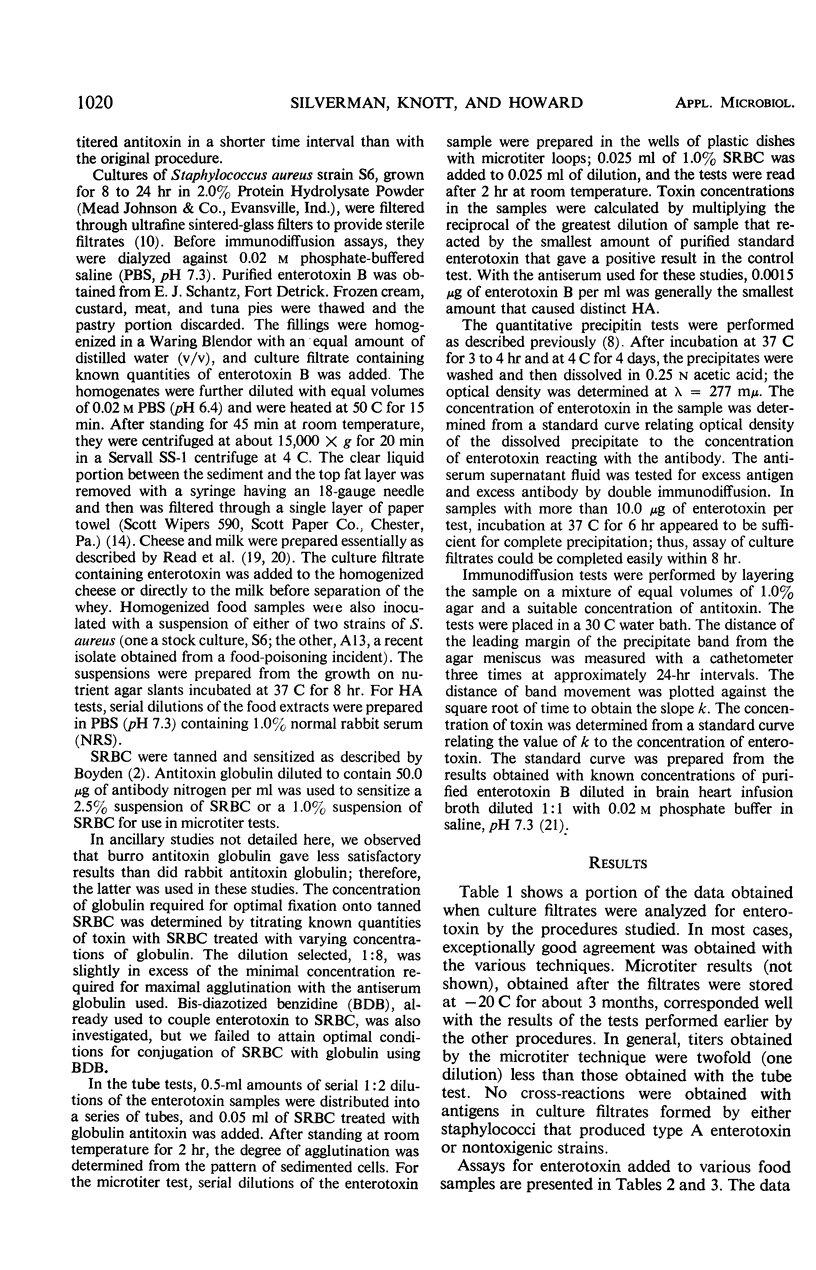
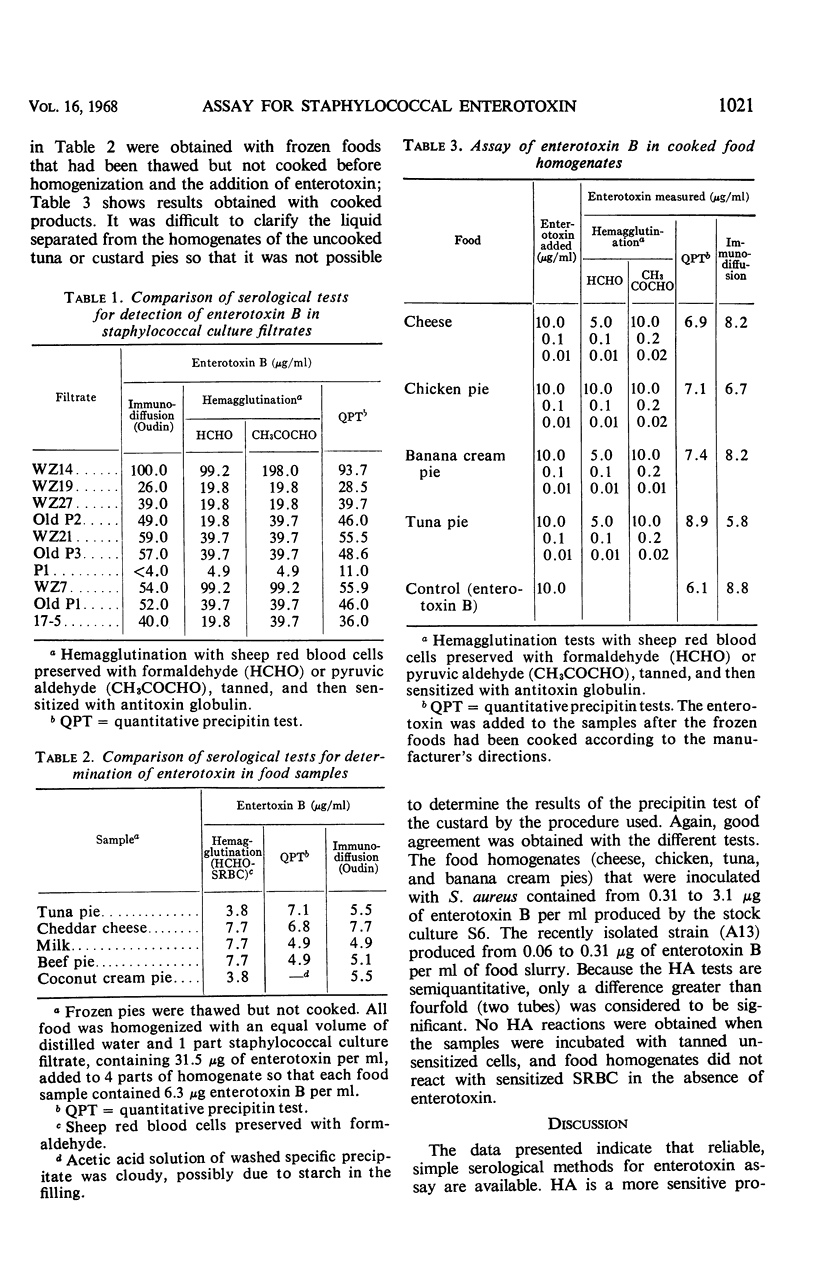
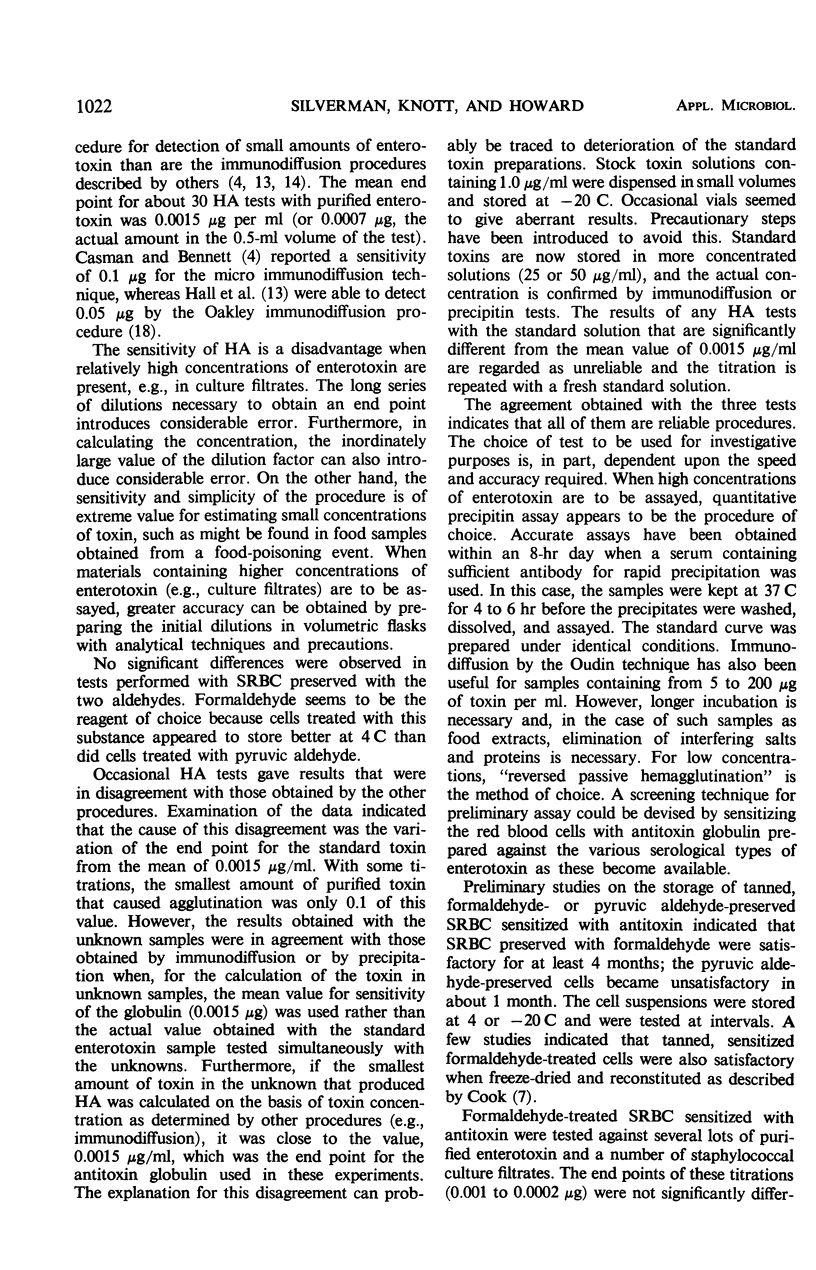
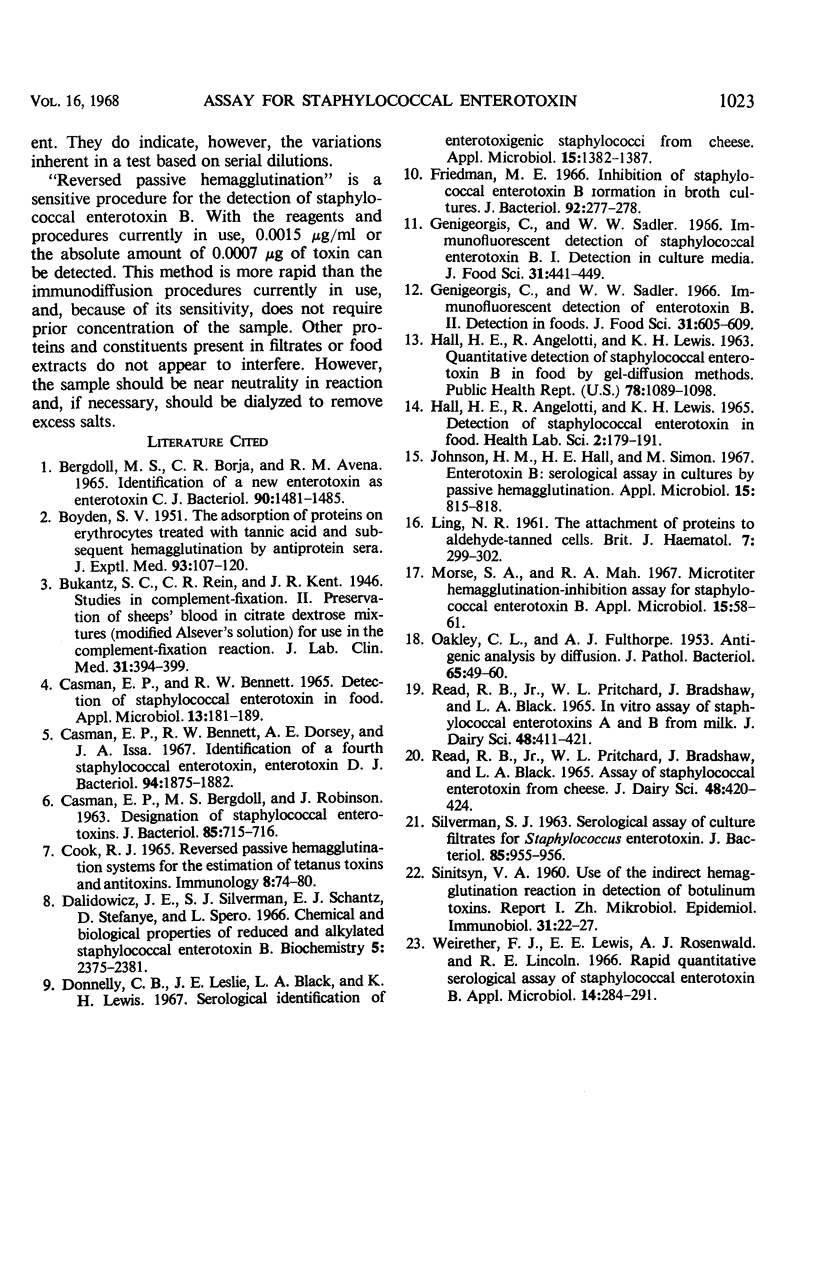
Selected References
These references are in PubMed. This may not be the complete list of references from this article.
- BOYDEN S. V. The adsorption of proteins on erythrocytes treated with tannic acid and subsequent hemagglutination by antiprotein sera. J Exp Med. 1951 Feb;93(2):107–120. doi: 10.1084/jem.93.2.107. [DOI] [PMC free article] [PubMed] [Google Scholar]
- Bergdoll M. S., Borja C. R., Avena R. M. Identification of a new enterotoxin as enterotoxin C. J Bacteriol. 1965 Nov;90(5):1481–1485. doi: 10.1128/jb.90.5.1481-1485.1965. [DOI] [PMC free article] [PubMed] [Google Scholar]
- CASMAN E. P., BENNETT R. W. DETECTION OF STAPHYLOCOCCAL ENTEROTOXIN IN FOOD. Appl Microbiol. 1965 Mar;13:181–189. doi: 10.1128/am.13.2.181-189.1965. [DOI] [PMC free article] [PubMed] [Google Scholar]
- CASMAN E. P., BERGDOLL M. S., ROBINSON J. DESIGNATION OF STAPHYLOCOCCAL EXTEROTOXINS. J Bacteriol. 1963 Mar;85:715–716. doi: 10.1128/jb.85.3.715-716.1963. [DOI] [PMC free article] [PubMed] [Google Scholar]
- COOK R. J. REVERSED PASSIVE HAEMAGGLUTINATION SYSTEMS FOR THE ESTIMATION OF TETANUS TOXINS AND ANTITOXINS. Immunology. 1965 Jan;8:74–80. [PMC free article] [PubMed] [Google Scholar]
- Casman E. P., Bennett R. W., Dorsey A. E., Issa J. A. Identification of a fourth staphylococcal enterotoxin, enterotoxin D. J Bacteriol. 1967 Dec;94(6):1875–1882. doi: 10.1128/jb.94.6.1875-1882.1967. [DOI] [PMC free article] [PubMed] [Google Scholar]
- Dalidowicz J. E., Silverman S. J., Schantz E. J., Stefanye D., Spero L. Chemical and biological properties of reduced and alkylated staphylococcal enterotoxin B. Biochemistry. 1966 Jul;5(7):2375–2381. doi: 10.1021/bi00871a029. [DOI] [PubMed] [Google Scholar]
- Donnelly C. B., Leslie J. E., Black L. A., Lewis K. H. Serological identification of enterotoxigenic staphylococci from cheese. Appl Microbiol. 1967 Nov;15(6):1382–1387. doi: 10.1128/am.15.6.1382-1387.1967. [DOI] [PMC free article] [PubMed] [Google Scholar]
- Friedman M. E. Inhibition of staphylococcal enterotoxin B formation in broth cultures. J Bacteriol. 1966 Jul;92(1):277–278. doi: 10.1128/jb.92.1.277-278.1966. [DOI] [PMC free article] [PubMed] [Google Scholar]
- HALL H. E., ANGELOTTI R., LEWIS K. H. DETECTION OF THE STAPHYLOCOCCAL ENTEROTOXINS IN FOOD. Health Lab Sci. 1965 Jul;2:179–191. [PubMed] [Google Scholar]
- HALL H. E., ANGELOTTI R., LEWIS K. H. QUANTITATIVE DETECTION OF STAPHYLOCOCCAL ENTEROTOXIN B IN FOOD BY GEL-DIFFUSION METHODS. Public Health Rep. 1963 Dec;78:1089–1098. [PMC free article] [PubMed] [Google Scholar]
- Johnson H. M., Hall H. E., Simon M. Enterotoxin B: serological assay in cultures by passive hemagglutination. Appl Microbiol. 1967 Jul;15(4):815–818. doi: 10.1128/am.15.4.815-818.1967. [DOI] [PMC free article] [PubMed] [Google Scholar]
- LING N. R. The attachment of proteins to aldehyde-tanned cells. Br J Haematol. 1961 Jul;7:299–302. doi: 10.1111/j.1365-2141.1961.tb00340.x. [DOI] [PubMed] [Google Scholar]
- Morse S. A., Mah R. A. Microtiter hemagglutination-inhibition assay for staphylococcal enterotoxin B. Appl Microbiol. 1967 Jan;15(1):58–61. doi: 10.1128/am.15.1.58-61.1967. [DOI] [PMC free article] [PubMed] [Google Scholar]
- OAKLEY C. L., FULTHORPE A. J. Antigenic analysis by diffusion. J Pathol Bacteriol. 1953 Jan;65(1):49–60. doi: 10.1002/path.1700650105. [DOI] [PubMed] [Google Scholar]
- READ R. B., Jr, BRADSHAW J., PRITCHARD W. L., BLACK L. A. ASSAY OF STAPHYLOCOCCAL ENTEROTOXIN FROM CHEESE. J Dairy Sci. 1965 Apr;48:420–424. doi: 10.3168/jds.s0022-0302(65)88246-7. [DOI] [PubMed] [Google Scholar]
- READ R. B., Jr, PRITCHARD W. L., BRADSHAW J., BLACK L. A. IN VITRO ASSAY OF STAPHYLOCOCCAL ENTEROTOXINS A AND B FROM MILK. J Dairy Sci. 1965 Apr;48:411–419. doi: 10.3168/jds.s0022-0302(65)88245-5. [DOI] [PubMed] [Google Scholar]
- SILVERMAN S. J. SEROLOGICAL ASSAY OF CULTURE FILTRATES FOR STAPHYLOCOCCUS ENTEROTOXIN. J Bacteriol. 1963 Apr;85:955–956. doi: 10.1128/jb.85.4.955-956.1963. [DOI] [PMC free article] [PubMed] [Google Scholar]
- SINITSYN V. A. [Use of the indirect hemagglutination method of detection of botulin toxins. Part I. Detection of botulin toxins type A and B with the aid of the indirect hemagglutination method (Rytsai modification)]. Zh Mikrobiol Epidemiol Immunobiol. 1960 Mar;31:22–27. [PubMed] [Google Scholar]
- Weirether F. J., Lewis E. E., Rosenwald A. J., Lincoln R. E. Rapid quantitative serological assay of staphylococcal enterotoxin B. Appl Microbiol. 1966 Mar;14(2):284–291. doi: 10.1128/am.14.2.284-291.1966. [DOI] [PMC free article] [PubMed] [Google Scholar]


